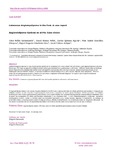Angiomiolipoma cutáneo en el pie. Caso clínico

View/
Use this link to cite
http://hdl.handle.net/2183/30218
Except where otherwise noted, this item's license is described as Atribución-NoComercial-CompartirIgual 4.0 Internacional (CC BY-NC-SA 4.0)
Collections
Metadata
Show full item recordTitle
Angiomiolipoma cutáneo en el pie. Caso clínicoAlternative Title(s)
Cutaneous Angiomyolipoma in the Foot. A Case ReportAuthor(s)
Date
2021-01-30Citation
Miñón Santamaría, C., Alonso Peña, D., Iglesias Aguilar, C., González Márquez, P. I., Estefanía Diez, M. E., & Pellicer Artigot, D. (2021). Angiomiolipoma cutáneo en el pie: Caso clínico. European Journal of Podiatry / Revista Europea de Podología, 6(2), 70-75. https://doi.org/10.17979/ejpod.2020.6.2.6355
Abstract
[Resumen] El angiomiolipoma cútaneo es la variante de partes blandas de los PEComas o tumores derivados de células epiteliodes perivasculares. Compuesto por múltiples variantes, la más conocida el angiomiolipoma renal (AML), comparten un mismo patrón histológico. Pueden presentarse en múltiples localizaciones como el tracto gastrointestinal, genitourinario o en los tejidos blandos. Son neoplasias histológicamente caracterizadas por abundantes vasos de pared fina acompañados de células perivasculares redondeadas y con citoplasma claro. A nivel inmunohistoquímico, coexpresan marcadores melanogénicos (HMB45, Melan-A o tirosina) junto con marcadores musculares (SMA, actina, miosina, calponina y h-caldesmon).. Sin embargo, su positividad errática y no patognomónica unida a la baja prevalencia, dificulta la identificación y la consideración dentro del diagnóstico diferencial. En este artículo se presenta un caso de angiomiolipoma cutáneo a nivel del pie derecho junto con un repaso breve de este tipo de tumores. [Abstract] Epithelioid angiomyolipoma is a type of perivascular epithelioid cell neoplasms (PEComas) related with soft tissues. Renal angiomyolipoma is the most known type. PEComas can appear in multiple locations such as gastrointestinal tract, genitourinary o soft tissues. Different variants share a histologic pattern characterized by abundant thin-walled vessels surrounded by perivascular cells with clear cytoplasm. Immunohistochemical stains reveal melanogenic markers (HMB45, Melan-A, or tyrosine) in addition to muscle markers (SMA, actin, myosin, calponin, and h-caldesmon). However, erratic and not pathognomonic positivity united to low prevalence, complicates differential diagnosis. We report a case of right foot cutaneous angiomyolipoma with a brief review of these tumours.
Keywords
Angiomiolipoma cutáneo
PEComa
Tumor de células epiteliodes perivasculares
Tumor de partes blandas
Cutaneous Angiomyolipoma
Perivascular epithelioid cell tumors
Soft tissue tumors
PEComa
Tumor de células epiteliodes perivasculares
Tumor de partes blandas
Cutaneous Angiomyolipoma
Perivascular epithelioid cell tumors
Soft tissue tumors
Editor version
Rights
Atribución-NoComercial-CompartirIgual 4.0 Internacional (CC BY-NC-SA 4.0)
ISSN
2445-1835






